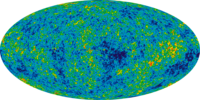
Photo from wikipedia
We propose a one-parameter extension to $\Lambda$CDM, expected to strongly affect cosmological tensions. An effective dark radiation component in the early universe redshifts away as hot dark matter, then quintessence,… Click to show full abstract
We propose a one-parameter extension to $\Lambda$CDM, expected to strongly affect cosmological tensions. An effective dark radiation component in the early universe redshifts away as hot dark matter, then quintessence, tracking the dominant equation-of-state parameter and leaving a falsifiable torsion field in the current epoch. This picture results from a new Poincare gauge theory (PGT), one of the most promising among the latest batch of 58 PGTs found to be both power-counting renormalisable and free from ghosts and tachyons. We systematically categorise the cosmologies of 33 of these PGTs, as special cases of the most general parity-preserving, Ostrogradsky-stable PGT with a purely Yang-Mills action. The theory we consider contains two propagating massless gravitons, which may be $J^P=2^+$ (long-range gravitation and gravitational waves). A conspiracy among the coupling constants eliminates the spatial curvature $k\in\{\pm 1,0\}$ from the field equations. We show that this `$k$-screening' is not restricted to conformal gravity theories. The flat Friedmann equations are then emergent, with potentially tension-resolving freedom at the early scale-invariant epoch that reliably gives way to an attractor-like state of modern $\Lambda$CDM evolution. We compare with related theories and promising special cases, such as $k$-screened theories with negative-definite effective $k$, and more traditional theories with effective $\Lambda$ and a $J^P=0^-$ massive graviton (dark matter candidate). As a bonus, we analyse similarly constrained actions in the new extended Weyl gauge theory (eWGT). We show that in cosmology, PGT and eWGT span exactly the same classical phenomenology up to a linear map between their coupling constants, hinting at a deeper relationship between the two.
Journal Title: Physical Review D
Year Published: 2020
Link to full text (if available)
Share on Social Media: Sign Up to like & get
recommendations!